Career Fire Fighter Dies After Being Trapped in a Roof Collapse During Overhaul of a Vacant/Abandoned BuildingMichigan
 Death in the Line of Duty...A summary of a NIOSH fire fighter fatality investigation
Death in the Line of Duty...A summary of a NIOSH fire fighter fatality investigation
F2008-37 Date Released: January 31, 2010
SUMMARY
On November 15, 2008, a 38-year-old male fire fighter (the victim) died after being crushed by a roof collapse in a vacant/abandoned building. Fire fighters initially used a defensive fire attack to extinguish much of the fire showing from the second-floor windows on arrival. After the initial knockdown, fire crews entered the second floor to perform overhaul operations. During overhaul, the roof collapsed with several fire fighters still inside, on the second floor. The victim and two other fire fighters were trapped under a section of the roof. Crews were able to rescue two fire fighters (who self-extricated), but could not immediately find the victim. After cutting through roofing materials, the victim was located by fire fighters, unconscious and unresponsive. He was removed from the structure and transported to a local hospital where he was pronounced dead. Key contributing factors identified in this investigation include: dilapidated building conditions, incendiary fire originating in the unprotected structural roof members, inadequate risk-versus-gain analysis prior to committing to interior operations involving a vacant/abandoned structure, inadequate accountability system, lack of a safety officer, an inadequate maintenance program for self-contained breathing apparatus (SCBA) and a poorly maintained and likely inoperable personal alert safety systems (PASS), ineffective strategies for the prevention of and the remediation of vacant/abandoned structures and arson prevention.
NIOSH investigators concluded that to minimize the risk of similar occurrences, fire departments should:
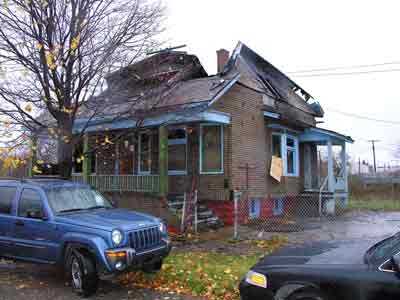 |
|
(Photo courtesy of the fire department arson unit.)
|
- ensure that the incident commander conducts a risk-versus-gain analysis prior to committing to interior operations in vacant/abandoned structures and continues the assessment throughout the operations
- ensure SOPs are developed for fighting fires in vacant/abandoned buildings
- ensure that the incident commander maintains close accountability for all personnel operating on the fireground
- ensure that a separate incident safety officer, independent from the incident commander, is appointed at each structure fire
- ensure that a respiratory protection program is in place to provide for the selection, care, maintenance, and use of respiratory protection equipment, including PASS devices.
Additionally, municipalities and local authorities having jurisdiction should:
- develop strategies for the prevention of and the remediation of vacant/abandoned structures and for arson prevention.
Although there is no evidence that the following recommendations could have prevented this fatality, NIOSH investigators recommend that fire departments:
- ensure that an EMS unit is on scene and available for fire fighter emergency care at working structure fires
- develop inspection criteria to ensure that all protective ensembles meet the requirements of NFPA 1851, Standard on Selection, Care, and Maintenance of Protective Ensembles for Structural Fire Fighting and Proximity Fire Fighting
- be aware of programs that provide assistance in obtaining alternative funding, such as grant funding, to replace or purchase fire equipment that can support critical fire department operations.
INTRODUCTION
On November 15, 2008, a 38-year-old male career fire fighter (the victim) died after a roof collapsed trapping the fire fighter during overhaul on the second floor of a vacant/abandoned residence. The victim was extricated by fire fighters and transported by emergency medical services (EMS) crews to a local hospital where he was pronounced dead. On November 17, 2008, the U.S. Fire Administration notified the National Institute for Occupational Safety and Health (NIOSH) of this incident. On December 9, 2008, a safety and occupational health specialist and a general engineer from the NIOSH Fire Fighter Fatality Investigation and Prevention Program traveled to Michigan to investigate this incident. The NIOSH investigators met with representatives from the fire commissioners office, the incident commander, officers and fire fighters from the first-due companies, representatives from the local International Association of Fire Fighters, the departments SCBA maintenance technician, members of the departments arson investigation division, and representatives of the buildings previous insurance company. The NIOSH investigators reviewed the victims and the incident commanders training records, the departments standard operating procedures (SOPs), medical examiners report, fire incident records, insurance company investigative report from a previous fire at the same location, witness statements, and copies of the dispatch radio tapes. Photographs of the incident scene prior to the fire were obtained from the insurance company. Photographs of the post-fire incident scene were obtained from the departments arson investigation unit. NIOSH investigators examined and photographed the victims turnout gear. NIOSH investigators also attempted to locate the victims SCBA and PASS device, but could not locate with certainty the exact SCBA and PASS device worn by the victim in this incident.
FIRE DEPARTMENT
The department involved in this incident is a career fire department consisting of 1,326 members serving a population of approximately 800,000 in a geographical area of about 148 square miles. The department has a minimum staffing of 4 fire fighters on 38 engines, 22 ladder companies, and 6 squads and responds to approximately 21,000 incidents annually.
Financial burdens and hardships have impacted the major automotive industries in this city, and those hardships have impacted the city and the fire department. The financial hardships on the city and the department are significant with the increased demand for service, such as the number of working fires, and the decreased level of available tax base.
The fire department protects a major metropolitan area that has seen a reduction in population due to the decline in the automotive industry. The area served by the department contained an estimated 60,000-86,000 vacant/abandoned properties.a Vacant buildings can fall into two categories, those that are vacant of residents awaiting sale and those that are vacant and abandoned and may be in different stages of decay or dilapidation from previous fires. These vacant properties in this departments response area are in different levels of physical condition (see Photos 1–6). Some are vacant awaiting new tenants, but a large number of the vacant properties that pose the greatest hazard to fire fighters are abandoned, dilapidated or poorly maintained residential, commercial, and industrial buildings. A significant number of vacant properties have sustained previous fire damage and have not been repaired or demolished. Many of the structures appear to be vacant and/or abandoned, but are inhabited regularly by homeless persons or families. Although many of the structures do not have utilities such as electricity and gas, fire fighters report finding make-shift utility connections and alterations for heat and light (see Photo 2). During this investigation, NIOSH investigators witnessed lights coming from abandoned structures where the electricity had been disconnected.
The fire department has been reduced in size, both in the number of fire fighters and the number of individual companies. The department regularly closes companies for periods of time due to staffing shortages. Although the size of the department has declined, the number of working fires for the department has increased. Arson fires in the vacant structures are common, and the fire department responds to working fires in these structures on a regular basis. Photographs of common vacant/abandoned/derelict structures in the response area of the department are included to illustrate the challenges that this department faces in both heavy industrial and residential vacant property fires (see Photos 1–6).
The engine and squad company involved in this fatality serves such an area. The officers and fire fighters involved in this incident reported that this residential fire was routine and it would not be unusual to have a number of these fires in one shift. Many of the fire fighters and officers involved in this incident have many years on the job with extensive experience fighting this type of fire.
The fire department does have SOPs for operations involving building fires and a separate SOP for vacant or abandoned buildings. The vacant/abandoned building SOP is from 1989 and describes procedures that apply to vacant/abandoned buildings such as: additional hazards because of unsafe structural conditions, rescue applicability, use of monitors for fire knockdown and withholding fire fighters until monitor operations are complete, consideration for the structural soundness of buildings that would necessitate a defensive mode, risk to personnel and establishing a perimeter around the building if needed.
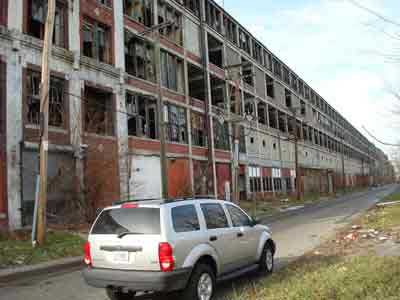 |
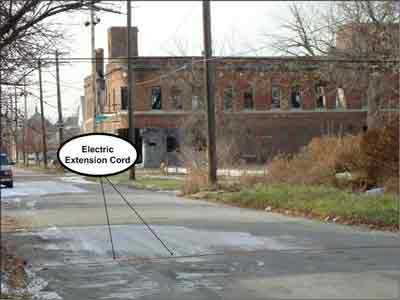 |
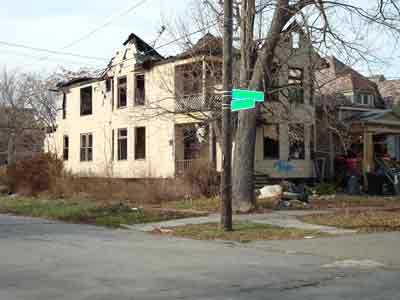 |
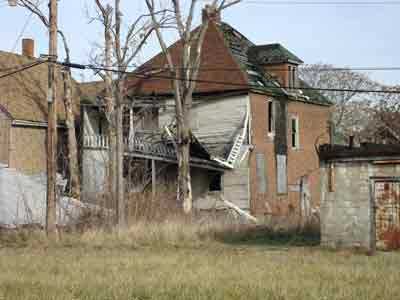 |
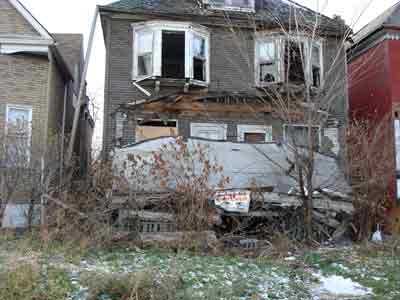 |
 |
|
Photo 6. Vacant/Abandoned industrial building. The building has reportedly experienced several fires and has numerous hazards such as open floors and areas that have been vandalized by persons seeking scrap metal and fixtures. (Photo by NIOSH.) |
a Estimates obtained from fire department, fire fighters union and various news articles.
STRUCTURE
The structure involved in this incident was a 1,200-square-foot, 2-story, vacant, unsecured bungalow-style residence with a gable roof, which had experienced a previous incendiary fire while being renovated approximately one year before this incident (see Photos 712). The previous fire did not extend into the structural elements of the house, and the fire damage had not been repaired and no further renovation took place. The house was boarded up and was not re-occupied. The house was not repaired and remained in the same condition with large areas of exposed wall and roof assemblies. Collar beamsb were not present and were possibly removed to increase head room in the second-floor space (see Photo 8). The fatal fire on November 15, 2008 (this incident), was also reported to be incendiary. The fire investigators determined that the fire originated in multiple areas on the second-floor south wall (Side C) in vapors of a flammable liquid distributed in the interior and ignited with an open-flame device.
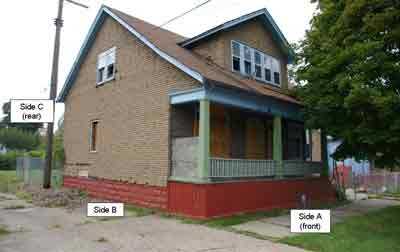 |
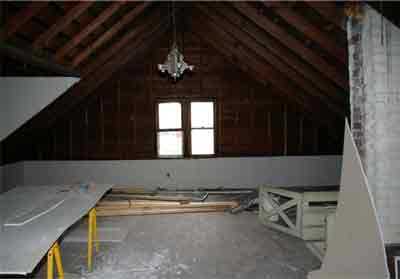 |
|
Photo 8. Room where collapse occurred killing the fire fighter, looking toward the interior of Side B. Photo |
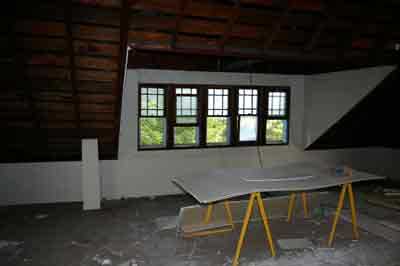 |
Photo 9. Room where collapse occurred, looking at the interior of dormer window on Side A. Photo taken approximately one year prior to the fatal incident. |
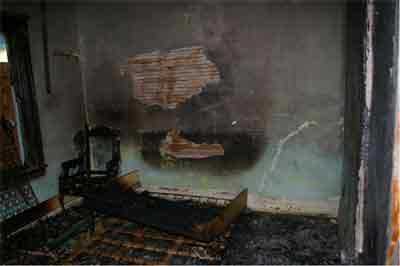 |
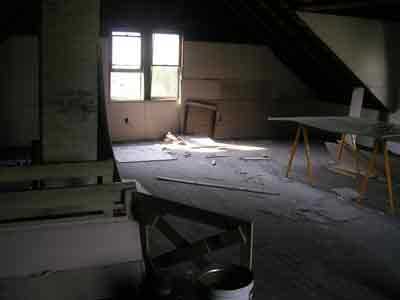 |
Photo 11. Second floor, looking toward Side D. Photo taken approximately one year prior to the fatal incident. Note: This was the staircase that crews from E-23 (including the victim who was third on the hoseline), Squad 3 and E-46 used to stretch a 1 ½” hoseline to the second floor. |
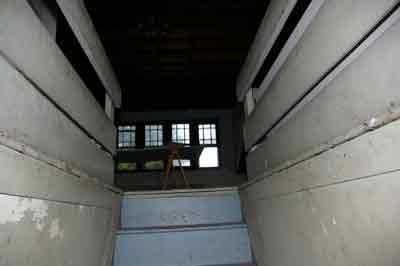 |
|
Photo 12. Interior stairs leading to second floor. Photo taken approximately one year prior to the fatal incident. Note: E-23s lieutenant and other fire fighters reported being forced down this staircase when the roof collapsed. |
b Collar beams are ties between rafters on opposite sides of the roof, used to connect rafters together. If the attic is to be used for rooms, the collar beam may double as a ceiling joist. 1
TRAINING/EXPERIENCE
The department requires all fire fighters to complete the departments 22-week basic fire fighting training program which includes Fire Fighter 1 and 2, driver training, NIMS 100-500, hazardous materials awareness and operations training, and first-responder medical training.
The victim in this incident had approximately 17 years of experience as a professional fire fighter with this department. He had completed the departments required training and had additional training in incident command (Battalion School), hazardous materials and drivers training.
The incident commander, (Battalion Chief) in this incident had approximately 36 years of experience as a professional fire fighter and officer with this department and had completed fire fighter and officer training throughout his career including incident command training, unified command, building construction, NIMS ICS, 100, 200 and hazardous materials classes.
PERSONAL PROTECTIVE GEAR
Turnout gear examined by NIOSH investigators included a fire coat and pants manufactured in August 19, 2004, and listed as compliant with NFPA 19712000 standards. The turnout coat and pants were well worn with much of the reflective material worn away and repair patches covering large areas (see Photos 13 and 14).
Fire fighters on the scene reported that the victims PASS alarm did not activate. After the incident, the SCBA and PASS device used by the victim were not placed in a restricted access status and lacked a tracking record. NIOSH personnel could not locate with certainty the exact SCBA and PASS device worn by the victim in this incident. The most probable unit was located at the departments SCBA maintenance facility. This SCBA had been rebuilt by the maintenance personnel prior to the NIOSH investigators visit. Since the unit was rebuilt, NIOSH investigators did not recommend it be sent to the NIOSH lab for evaluation. The victims most probable PASS device was examined and found to be not working and missing a battery. A battery was installed by the maintenance technician and the PASS device would not function. NIOSH investigators recommended that the PASS device be sent to the NIOSH National Personal Protective Technology Laboratory (NPPTL) or the manufacturer to determine the reason for not functioning. SCBA records indicated that this SCBA unit was flow tested in March 2007. Interviews with the SCBA maintenance personnel indicated that the shop was unable to conduct an air flow test for a period of time due to broken test equipment. Records of breathing air quality checks indicated the last air quality tests were performed in January and February of 2004. According to NFPA 1989 Standard on Breathing Air Quality for Emergency Services Respiratory Protection [2008 edition]2 air quality requirements, at least quarterly, the organization shall take breathing air samples and shall submit such samples to an accredited testing laboratory that meets the requirements specified in chapter 4. In addition, NFPA 19892 also states the organization shall maintain documentation from the accredited testing laboratory of the results of air sample test for a period of not less than five (5) years.
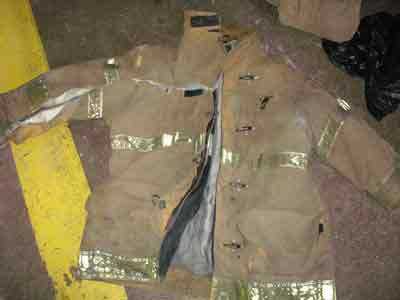 |
Photo 13. Turnout jacket shell and liner worn by victim.(Photo by NIOSH.) |
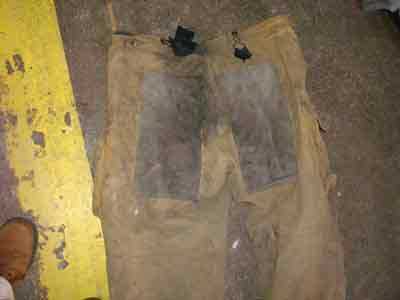 |
Photo 14. Repaired areas of the turnout pants shell. |
TIMELINE
- 0506 hours
Box alarm. Units dispatched for dwelling fire: Engines 9, 23, 46, Ladder 16, Squad 3, Chief 1. - 0507 hours
Units responding: Engines 9, 23, 46, Ladder 16, Squad 3, Chief 1. - 0510 hours
Engines 46, 23 and Squad 3 on scene. Engine 46 reports, “It’s going throughout.” Dispatch acknowledges working fire. Engine 23 transmits on scene, “We’re going to dump our monitor and stretch.” - 0512 hours
Ladder 16 on scene. Engine 9 on scene advises they are going to dump their monitor. - 0513 hours
Chief 1 on scene, reporting, We have a 2-story dwelling going, holding all companies, requesting another company for RITc . - 0513 hours
Ladder 10 dispatched for RIT. - 0515 hours
Ladder 10 responding. - 0518 hours
Ladder 10 on scene, RIT - 0521 hours
Chief 1 reports to dispatch, I have a RIT in place and we are making progress. Chief 1 request EMS for standby. - 0522 hours
Squad 3 transmits to dispatch, Central, this is Squad 3. I need EMS on the scene immediately. Dispatch asks Squad 3 why he needs EMS, for a civilian or fire fighter victim. Squad 3 responds, Thats a possible injured fire fighter, Central. Let me have another company for manpower. - 0523 hours
Dispatch notifies Chief 1 and Squad 3 that EMS is giving a 7-minute estimated time of arrival (ETA) for their arrival at the scene. - 0523 hours
Ladder 19 dispatched for additional manpower. - 0525 hours
Ladder 19 responding. - 0526 hours
Chief 1 notifies Dispatch, We have a trapped fire fighter. Right now we have crews working on freeing him up. - 0530 hours
Chief 1 requests an ETA on EMS from dispatch. - 0530 hours
Dispatch advises Chief 1 that EMS is arriving on the scene. - 0531 hours
Ladder 19 on scene. - 0540 hours
Victim is transported to a local hospital by EMS. - 0543 hours
EMS arrives at hospital with victim. - 0612 hours
Chief 1 advises Dispatch that the fire is out and companies are picking up lines. - 0652 hours
Ladder 16 clears scene and reports arson investigators on scene.
c Rapid Intervention Team
WEATHER CONDITIONS
At the time of the fire, the temperature was 44° F, winds were 9 mph gusting to 22 mph from the north/ north east, and visibility was 9 miles.3
INVESTIGATION
On November 15, 2008, a 38-year-old male career fire fighter (the victim) died after being crushed by a roof collapse in a vacant/abandoned building. The victim was trapped under a section of roof that collapsed while fire fighters were overhauling the second floor of a two-story vacant residential bungalow. The victim was operating on a hoseline performing overhaul with other fire fighters when the collapse occurred.
The fire department dispatched three engines, three ladders, two squads, and a battalion chief to a dwelling fire in a vacant, two-story residence. First-arriving units advised heavy fire showing from all windows on the second floor and began a defensive operation using their deck guns from Side A and Side B into the windows on the second floor (see Photo 7). Engine 46, Engine 23 (the victim), and Squad 3 arrived on the scene in 4 minutes at 0510 hours. Ladder 16 and Engine 9 arrived 2 minutes later, followed by Chief 1 at 0513 hours. The responding battalion chief assumed command on arrival on Side A and requested another company for RIT duties. Ladder 10 (RIT) arrived at 0518. The bulk of the fire was knocked down on the second floor from the exterior, and crews switched to an offensive mode and stretched hand lines inside to the second floor to extinguish the remaining fire.
A roof ladder had been placed on Side A, and two truck company personnel from Ladder 16 used that ladder to climb up on the roof to begin venting operations using pick head axes (ladder crews reportedly did not have power or chain saws). Fire fighters reported that the roof was extremely difficult to vent due to multiple layers of shingles on top of cedar shakes and 1-in x 6-in boards over the roof rafters. The ladder crew used axes to cut two 1-ft x 2-ft holes in the roof between the chimney and the ridge, toward Side D. The aerial ladder was then repositioned on Side A and placed to the roof.
A total of nine fire fighters began operating on the second floor. Two fire fighters from Engine 46, one fire fighter from Engine 23, and one fire fighter from Squad 3 used a 20-ft extension ladder and stretched a hoseline into the second floor via a dormer window on Side A (see Photo 9 and note on page 8). Two fire fighters from Engine 23 (including the victim who was third on the hoseline), one fire fighter from Engine 46, and two fire fighters from Squad 3 entered the structure through an unsecured door on Side D on the first floor and stretched an 1 ½-in hoseline up the interior stairs (see Photos 11,12). The engine officer and a fire fighter from Squad 3 reported seeing a hole in the roof when they reached the top of the interior stairs. Interior crews were using two 1 ½-in hand lines on the second floor, extinguishing the remaining fire, when the roof collapsed trapping the victim and the nozzle man from E-23. The nozzle man on Engine 23s hoseline stated during interviews that he was using the nozzle to vent through the windows on Side D (see Photo 11 ) before the collapse when the roof pushed him down to where his chest was pushed to his knees and he was able to take two breaths, but couldnt get a third breath. The nozzle man then turned sideways between the roof rafters and was able to self extricate. One other fire fighter was briefly pinned and also self extricated. The victim was reportedly operating approximately 6 ft to the right and center of the room from the gate at the top of the stairs (see Photo 8). Engine 23s lieutenant was operating at the top of the stairs and stated during interviews that he was pushed down the narrow stair case along with other fire fighters when the collapse occurred. The two fire fighters on the roof were able to escape by quickly grabbing the aerial ladder that had been raised to Side A. Fire fighters reported that the roof collapse began on Side C, followed by Side A (with dormer), and Side B followed by Side D. The roof collapsed on top of the first floor with the first-floor walls and floor stopping further collapse.
The incident commander reported hearing a loud crack and saw the fire fighters on the roof hanging from the aerial ladder. Command ordered a head count and requested an EMS unit to respond to the scene. The RIT crew was activated and worked with the other crews to locate and remove the fire fighters. None of the fire fighters interviewed reported hearing the victims PASS alarm sounding. The victim was found minutes later under a large portion of the roof. Fire fighters had to cut through the layers of roof materials to extricate the victim. The victim was removed and transported to the hospital where he was pronounced dead. Although the officers of the crews knew which fire fighters were assigned to which crews, an accountability system with the names and assignments of the responding crews could have assisted the incident commander in knowing the location and names of the fire fighters operating more quickly. In this incident, the incident commander did not have any personnel assigned to assist with accountability, such as a field incident technician or another responding chief or safety officer. No formal accountability system or riding lists were in place. Squad 3 communicated directly with dispatch to request an ambulance for an injured fire fighter and requested another company for manpower. Three minutes later, command notified dispatch, We have a trapped fire fighter. Right now we have crews working on freeing him up. The incident commander could have benefited by having assistance such as a field technician or aide to assist in operating the accountability system while he concentrated on the fire scene management.
CONTRIBUTING FACTORS
Occupational injuries and fatalities are often the result of one or more contributing factors or key events in a larger sequence of events that ultimately result in the injury or fatality. NIOSH investigators identified the following items as key contributing factors in this incident that ultimately led to the fatality:
- Dilapidated conditions of the building.
- Incendiary fire originating in the unprotected roof structural members.
- Inadequate risk-versus-gain analysis prior to committing to interior operations involving vacant/abandoned/derelict structures.
- Inadequate accountability system.
- Lack of a safety officer.
- Inadequate SCBA maintenance program and poorly maintained and likely inoperable PASS device.
- Ineffective strategies for the prevention of and the remediation of vacant/abandoned structures and arson prevention.
CAUSE OF DEATH
The cause of death was reported as mechanical asphyxia.d
d Mechanical asphyxia results when heavy weight on the chest or upper abdomen prevents respiration.
RECOMMENDATIONS
Recommendation #1: Fire departments should ensure that the incident commander conducts a risk-versus-gain analysis prior to committing to interior operations in vacant/abandoned structures and continues the assessment throughout the operations.
Discussion: Vacant building fires pose a threat to fire fighters. Based on NFPA statistics, during the ten-year period 19982007, a total of 15 fire fighters were fatally injured at the scene of vacant structure fires. On average, 4,500 fire fighters were injured at vacant building fires annually during 20032006. These account for 13% of the reported fire fighter injuries incurred at structure fires per year during this period.4
Jon C. Jones, project manager for the International Association of Arson Investigators (IAAI) of the United States Fire Administration (USFA), notes, The most important concept that firefighters and command officers must understand when responding to fires involving vacant and abandoned buildings is that the buildings themselves are inherently dangerous. Hazards commonly found in these buildings include open shafts; pits and holes due to removal of equipment; structural degradation due to weather and vandalism; exposed structural members; penetrations in barriers such as walls, floors and ceilings that allow abnormal fire travel; combustible contents; maze-like configuration; blocked or damaged stairs; potential for delay in discovery of a fire; potential for multi-room fire on arrival; and potential for extension to nearby structures.5
Fire fighting operations in buildings that are known to be vacant should be conducted with extreme caution. Interior firefighting operations should be attempted only after a size-up has determined that these operations can be conducted safely. 5
Where there are indications of structural deterioration or other hazards listed above and no known life hazard, the incident commander should consider defensive operations.5
The decision to commit interior firefighting personnel should be made on a case-by-case basis with proper risk-benefit decisions being made by the incident commander. The commitment of firefighters lives for saving property and an unknown or marginal risk of civilian life must be balanced appropriately.5
The initial size-up conducted by the first arriving officer allows the officer to make an assessment of the conditions and to assist in planning the suppression strategy. The following general factors are important considerations during a size-up: occupancy type involved; potential for civilians in the structure; smoke and fire conditions; type of construction; age of structure; exposures; and time considerations such as the time of the incident, length of time fire was burning before arrival, and time fire was burning after arrival.6,7 The incident commander must perform a risk analysis to determine what hazards are present, what the risks to personnel are, how the risks can be eliminated or reduced, and the benefits to be gained from interior or offensive operations.8 The size-up must include continued assessment of risk versus gain during incident operations. According to NFPA 1500 §A-8.3.3,9 The acceptable level of risk is directly related to the potential to save lives or property. Where there is no potential to save lives, the risk to the fire department members must be evaluated in proportion to the ability to save property of value. When there is no ability to save lives or property, there is no justification to expose fire department members to any avoidable risk, and defensive fire suppression operations are the appropriate strategy.9,10 Retired New York City Fire Chief Vincent Dunn states, When no other persons life is in danger, the life of the firefighter has a higher priority than fire containment.11
Size-up includes assessing risk versus gain at the start and throughout the fire operations. Incident commanders should ensure that fire fighter safety is the primary consideration when switching from a defensive mode to an offensive position to perform overhaul.
This incident occurred in a vacant unsecured residential structure which had experienced a previous fire approximately one year prior to this incident. During interviews with NIOSH investigators, fire fighters reported large amounts of fire showing from all windows on the second floor on arrival. Fire fighters also reported that the roof had burned through on the Side B/C and one fire fighter reported he could see the sky while ascending the interior stairs to perform overhaul. It is not known if the roof conditions were communicated to the incident commander before fire fighters were assigned to operate on the roof. The fire fighters were unaware of the conditions such as the exposed roof assembly, possible removal of rafter connectors (collar beams), and the use of a flammable liquid in the structural members of the roof and second floor attic area. The roof assembly (being unprotected) was directly involved as part of the fuel in this fire. The large dormer on the A-side presents an identifiable inherent risk factor (due to the potential for structural compromise or failure) when found on 1.5 story bungalow style residential structure due to the integral manner in which the dormer structure, i.e., roof rafters, dormer framing and roofing boards along with the functionality of the ridge beam must function in order to retain structural integrity under fire conditions. The dormer may be actually supported at the upper end directly onto the roofing boards, which in turn are supported by the perpendicular roof rafters. This creates a potential area for pronounced degradation when exposed to direct or indirect flame impingement creating an area prone to early structural compromise and eventual failure. Although the initial defensive strategy in fighting the fire was successful in knocking down the fire, the incident commander may have benefited from a continuous risk-versus-gain analysis before allowing crews to operate on interior during overhaul. The first arriving officer reported that he performed a walk around prior to allowing crews to enter the structure and the building appeared intact, but he would not have known of the alterations to the interior roof system and the removal of critical structural members. Interior condition and roof condition reports might have revealed the burned-through area of the roof, and tactics could have been altered to keep fire fighters off the roof and out of the structure.
Recommendation #2: Fire departments should ensure SOPs are developed for fighting fires in vacant/abandoned structures.
Discussion: Philadelphia Deputy Fire Chief James Smith described two basic types of vacant buildings. The first is awaiting resale and is basically the same as any other building. The second type has been vacant for a longer period and has been stripped of things that could be sold, such as piping and cabinetry. This type of building could not be used for legitimate occupancy without extensive renovation and may be abandoned by the owner. These properties are particularly dangerous to fire fighters.12 Homes accounted for almost two-thirds of vacant building fires, and fires in vacant buildings are more likely to have been intentionally set than other structure fires.5
Vacant buildings can and do pose numerous hazards to the health and safety of fire fighters. Hazards can be structural as the result of building deterioration or damage from previous fires. Structural hazards can occur when building owners or salvage workers remove components of the building such as doors, railings, windows, electric wiring, utility pipes, etc. Collapse hazards can include chimney tops, parapet walls, slate and tile roof shingles, metal and wood fire escapes, advertising signs, and entrance canopies.
Retired FDNY Chief Vincent Dunn wrote that many vacant buildings have had a series of fires and fire department overhauls.13 With no repairs made after these fires, holes in floors, walls, stairs, and roofs are common. Stripping metal for scrap also causes damage. Sealed buildings may be vandalized and re-opened. Regular inspections are needed to ensure that properties are continually resealed.
Information regarding the status of a structure would be invaluable to fire fighters should an incident occur. Hazards should be identified and warning placards affixed to entrance doorways or other openings to warn fire fighters of the potential dangers. Fire departments should consult with fire prevention, code enforcement and/or building departments to consider requiring an exterior placard or markings on abandoned and vacant structures to inform fire fighters of the structures status and identify potential hazards.13,14 For example, a warning placard may be a 12-inch-square piece of metal painted reflective yellow so that it glows in the dark and indicates to fire fighters the occupancy status and of the existence of any hazards inside the building. The following is an example of symbols developed and used by the Fire Department of New York City (FDNY) on exterior building placards.
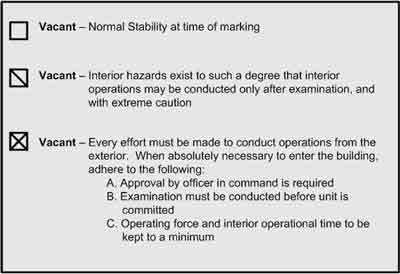 |
Identifying and marking of vacant, abandoned, and derelict structures is one component of a larger program that fire departments should implement to fight fires in these types of structures. Fire departments should develop additional policies that specifically cover the hazards encountered with these structures, such as training in size-up, building construction features present in typical buildings and construction methodologies characteristic of this era, safety considerations, tactics and strategy, and risk-versus-gain profiles.
In this incident, the structure had suffered a previous incendiary fire approximately one year prior to this fire. The previous fire involved a first-floor, room-and-contents fire, which had multiple points of origin, and fire damage was confined to the fire floor. The fire did not extend into the structural elements of the house, and, after the fire, the house was boarded up. The house was not repaired and remained in the same condition with large areas of exposed wall and roof assemblies. Collar beams were not present and were possibly removed to increase head room in the second-floor space (see Photo 8).
The departments arson unit reported that vandals were able to gain entry via an unsecured door and ignite a flammable liquid on the second floor, Side C wall area, causing a well-involved fire with flames showing from all windows on the second floor, as reported by first-arriving crews. If the building had been marked, fire fighters would have known of the previous fire and any hazards and sized up the fire accordingly. First-arriving crews began a defensive fire attack with deck guns but switched to an offensive attack after the fire was knocked down. The second-floor walls and roof assembly were not protected with sheet rock and were directly affected by the fire, which weakened the walls and roof much sooner than would have been expected.
The department does have an SOP for vacant/abandoned buildings, but hasnt been updated since 1989 and does not address building marking and identification, training in size-up, risk-versus-gain profiles. Over a 20 year period, changes have occurred in the city and the department that affect staffing, available equipment and resources, number of vacant/abandoned buildings and other considerations that would necessitate a review of the policy and possible program updates.
Recommendation #3: Fire departments should ensure that the incident commander maintains close accountability for all personnel operating on the fireground.
Discussion: Personnel accountability on a fireground means identifying and tracking all personnel working at the incident. A fire department should develop its own system and standardize it for all incidents. Accountability on the fireground can be maintained by several methods: a system using individual tags assigned to each fire fighter, a riding list provided by the company officer, a SCBA tag system, or an incident command board.9,15,16 Modern radio systems also incorporate a means of tracking the identity of fire fighters at an incident scene.
As the incident escalates, additional staffing and resources will be needed, adding to the burden of tracking personnel. An incident command board should be established at this point with an assigned accountability officer or aide. The incident commander should also utilize an incident management system. Additionally, fire fighters should not work beyond the sight or sound of their supervising officer unless equipped with a portable radio.
As a fire escalates and additional fire companies respond, a chiefs aide or accountability officer assists the incident commander with accounting for all fire fighting companies at the fire, at the staging area, and at the rehabilitation area. With an accountability system in place, the incident commander may readily identify the location and time of all fire fighters on the fireground.
In this incident, the incident commander did not have any personnel assigned to assist with accountability, such as a field incident technician or another responding chief or safety officer. No accountability system or riding lists were in place. Squad 3 communicated directly with dispatch to request an ambulance for an injured fire fighter and requested another company for manpower. Three minutes later, command notified dispatch, We have a trapped fire fighter. Right now we have crews working on freeing him up. The incident commander can quickly become task saturated with strategic and tactical level assignments and may miss important accountability benchmarks. The incident commander should detail a member of the responding units who is trained in accountability to assist at the command post. During interviews, fire fighters and officers described this incident as routine, and similar strategy and tactics including the lack of a formal accountability system had been used on many other similar incidents.
Recommendation #4: Fire departments should ensure that a separate incident safety officer, independent from the incident commander, is appointed at each structure fire.
Discussion: According to NFPA 1561 Standard on Emergency Services Incident Management System, 2008 Edition, paragraph 5.3, The Incident Commander shall have overall authority for management of the incident (5.3.1) and the Incident Commander shall ensure that adequate safety measures are in place (5.3.2). This shall include overall responsibility for the safety and health of all personnel and for other persons operating within the incident management system. While the incident commander is in overall command at the scene, certain functions must be delegated to ensure adequate scene management is accomplished.16 According to NFPA 1500 Standard on Fire Department Occupational Safety and Health Program, 2007 Edition,9 as incidents escalate in size and complexity, the Incident Commander shall divide the incident into tactical-level management units and assign an incident safety officer (ISO) to assess the incident scene for hazards or potential hazards (8.1.6). These standards indicate that the incident commander is in overall command at the scene but acknowledge that oversight of all operations is difficult. On-scene fire fighter health and safety is best preserved by delegating the function of safety and health oversight to the ISO. Additionally, the incident commander relies upon fire fighters and the ISO to relay feedback on fireground conditions in order to make timely, informed decisions regarding risk versus gain and offensive-versus-defensive operations. The safety of all personnel on the fireground is directly impacted by clear, concise, and timely communications among mutual aid fire departments, sector command, the ISO, and the incident commander.
Chapter 6 of NFPA 1521 Standard for Fire Department Safety Officer defines the role of the ISO at an incident scene and identifies duties such as recon of the fireground and reporting pertinent information back to the incident commander; ensuring the departments accountability system is in place and operational; monitoring radio transmissions and identifying barriers to effective communications; and ensuring established safety zones, collapse zones, hot zones, and other designated hazard areas are communicated to all members on scene.17 Larger fire departments may assign one or more full-time staff officers as safety officers who respond to working fires. In smaller departments, every officer should be prepared to function as the ISO when assigned by the incident commander. The presence of a safety officer does not diminish the responsibility of individual fire fighters and fire officers for their own safety and the safety of others. The ISO adds a higher level of attention and expertise to help the fire fighters and fire officers. The ISO must have particular expertise in analyzing safety hazards and must know the particular uses and limitations of protective equipment.18
In this incident, a designated safety officer could have assisted with continual size-up, accountability, and timely communications regarding safety on the fireground and the conditions of the structure.
Recommendation #5: Fire departments should ensure that a respiratory protection program is in place to provide for the selection, care, maintenance, and use of respiratory protection equipment, including PASS devices.
Discussion: The following standards address the maintenance and use of SCBA and PASS devices: NFPA 1981 Standard on Open-Circuit Self-Contained Breathing Apparatus for Emergency Services,19 NFPA 1852 Standard on Selection, Care, and Maintenance of Open-Circuit Self-Contained Breathing Apparatus,20 NFPA 1500 Standard on Fire Department Occupational Safety and Health Program,9 and NFPA 1989 Standard on Breathing Air Quality for Emergency Services Respiratory Protection.21
The SCBA is an integral part of the fire fighters protective ensemble, and fire fighters cannot safely enter hazardous environments requiring respiratory protection without a properly functioning SCBA. Fire departments need to ensure that all respiratory protection equipment is appropriate for the task and is in proper working order with no defects. All needed repairs must be completed thoroughly or proper replacements provided. Fire fighters need to be instructed in the proper use, care, and inspection of personal fire fighting gear. Department SOPs need to emphasize, and officers need to enforce, the proper inspection procedures for all respiratory protection equipment including SCBA and PASS devices. Department SOPs should include procedures to remove from service and replace defective respiratory protection equipment including PASS devices. According to NFPA 1852,20 when a SCBA is assigned to an individual user for a duty period, the individual user shall inspect the SCBA at the beginning of each duty period; when the SCBA has an integrated PASS, the inspection shall include the following assessments:
- Wear and damage.
- Covers/compartments for secure attachment.
- All operating modes for proper function.
- Low-battery warning signal.
NFPA 15009 states that each PASS device shall be tested at least weekly and prior to each use and shall be maintained in accordance with the manufacturers instructions. It is vital that departments have a systematic routine that requires the SCBA and all of its components (including the PASS device), be examined for readiness at the beginning of each tour of duty. Had the victim discovered that this component of the SCBA was not operational at the start of the tour, the unit could have been placed out of service and another functional unit placed in-service.
In this incident, the victims PASS device was reported as nonoperational after the roof collapsed. During interviews, fire fighters on the collapsed second floor who were close to the victim reported that they did not hear the victims PASS alarm. Other fire fighters involved in the rescue efforts stated that they could not hear his PASS device even after he was removed from the debris. NIOSH personnel located the most probable PASS device weeks later at the departments maintenance facility and found it to be nonoperational. Upon further inspection at the facility, the PASS device was found to not contain a battery. The PASS device did not work after a battery was installed by a technician at the maintenance facility. NIOSH investigators recommended that the PASS device be sent to NIOSH National Personal Protective Testing Laboratory or the manufacturer to determine the reason for the PASS device not functioning.
The departments SCBA maintenance facility reported that they had performed work on the victims SCBA since the incident and prior to the NIOSH visit; further examination of the SCBA would not yield complete information regarding performance at the time of the incident. NFPA 1989 Annex A.5.421 provides information organizations can use to secure SCBA equipment in the event of a fire fighter death. In the event of a emergency services personnel death, or if they become unconscious, or suffer a heart attack within 24 hours of using compressed breathing air, chain-of-custody procedures should be instituted, the respirator secured, the valve closed, and the respirator tagged and submitted to an accredited testing laboratory for analysis. Interviews with the SCBA maintenance personnel indicated that the shop was unable to conduct SCBA air flow test for a period of time due to broken test equipment. Available records of breathing air quality checks indicated the last breathing air quality tests were performed in January and February of 2004. NFPA 198921 states that at least quarterly, the organization shall take breathing air samples and shall submit such samples to an accredited testing laboratory and the organization shall maintain documentation of the air sample test for a period of not less than five years.
Additionally, municipalities and local authorities having jurisdiction should:
Recommendation #6: Municipalities and local authorities having jurisdiction should develop strategies for the prevention of and the remediation of vacant/abandoned structures and for arson prevention.
The best way to prevent vacant building fires is to prevent vacant buildings.4 The National Vacant Properties Campaign describes a number of strategies to address the problem of vacant properties and provides examples of how these strategies have been used.22 Strategies include the following:
- Vacant property registration ordinances that provide contact information and may generate fees to cover municipal cost associated with these properties.
- Land banks for property seized for nonpayment of taxes.
- Rental and point of sale inspection ordinances that ensure the property has been maintained when the occupants change.
- Rehabilitation programs for owner-occupied housing and home repair programs.
- Homeownership and landlord training programs.
- Foreclosure prevention.
- Information systems capturing data about individual properties and neighborhoods that allow developing problems to be identified, tracked, and addressed.
- Code enforcement that is typically complaint driven but may be institutionalized.
- Vacant property coordinators who interact with owners and municipal departments, emphasizing compliance more than enforcement.
- Property maintenance codes related to occupied housing that reduce the likelihood a property will fall into serious disrepair and abandonment.
- Nuisance abatement authority that allows municipalities to address threats to the general public, typically through administrative hearings rather than courts.
- Receivership (legal action that places property in dispute under the control of an independent person).
Arson prevention information is available at http://www.nfpa.org/~/media/files/public%20education/NFPAarsonpresentation.ashx (Link Updated 8/8/2013 - no longer available 10/28/2013)
On its web site, interFIRE provides a draft ordinance to address blighted structures and vacant lots based on Bridgeport, Connecticuts Anti-Blight Law, Aberdeen, Texass vacant lot ordinance, and procedures to secure buildings developed by the Department of Housing and Urban Development and the Federal Emergency Management Agency.4 InterFire has several other items from various sources relating to vacant buildings on its Web site at www.interfire.org/features/vacantbuildings.asp, including materials developed by the IAAI and the U.S. Fire Administration.
Although there is no evidence that the following recommendations could have specifically prevented this fatality, NIOSH investigators include the following recommendations.
Recommendation #7: Fire departments should ensure that an EMS unit is on scene and available for fire fighter emergency care at working structure fires.
Emergency medical care and transportation for injured or ill fire fighters should be immediately available on the scene of working structure fires. Many fire departments incorporate an automatic dispatch of an EMS unit to working structure fires. Automatic dispatch can help to ensure that qualified emergency medical care and transportation for injured or ill fire fighters is available without having to call and wait for a unit after a medical emergency or injury has occurred.
In this incident, the structure fire was reported as going through-out by E-46 at 0510. Chief 1 (the incident commander) called for an EMS unit to standby at 0521. At 0522, Squad 3 requested an EMS unit on the scene immediately. Dispatch asked why EMS was needed and Squad 3 radioed a possible injured fire fighter. At 0523 dispatch notifies Chief 1 and Squad 3 that EMS is giving an ETA of 7 minutes. At 0530 Chief 1 (the IC) requested an ETA on EMS and was told by dispatch that EMS was arriving on scene. At 0540 the victim was reported to be transported from the scene; the EMS unit arrived at a local hospital at 0543. Initial fire fighting operations were conducted for approximately 20 minutes before the arrival of an EMS unit.
The department involved in this incident provided automatic dispatch of EMS units only for second alarm and greater structural fires as well as occupied multiple dwelling fires and hazardous materials incidents. EMS units are not automatically dispatched to working residential fires and must be requested by the incident commander.
Recommendation #8: Fire departments should develop inspection criteria to ensure that all protective ensembles meet the requirements of NFPA 1851, Standard on Selection, Care, and Maintenance of Protective Ensembles for Structural Fire Fighting and Proximity Fire Fighting.
NFPA 1851 Standard on Selection, Care, and Maintenance of Protective Ensembles for Structural Fire Fighting and Proximity Fire Fighting23 provides specific requirements for the retirement of gear. Fire departments should develop specific criteria consistent with manufacturers recommendations for the removal of protective gear and clothing from service. Conditions that should be considered to retire protective gear or clothing include, but are not limited to the following:
- Physical damage from use or improper cleaning.
- Economical feasibility for repair. If more than 50% of replacement cost, then replace.
- Ability to remove hazards or provide thermal protection.
Protective ensembles that are retired should be disposed of or destroyed to ensure that they cannot be used in any emergency operation, fire fighting event, or training event.23
The latest edition of NFPA 1851,23 August 2007, recommends mandatory retirement for all structural fire fighting protective gear at 10 years from the date of manufacture, regardless of the level of use.
Recommendation #9: Fire departments should be aware of programs that provide assistance in obtaining alternative funding, such as grant funding, to replace or purchase fire equipment that can support critical fire department operations.
Discussion: While it is important that fire departments seek improvements and upgrades to their fire apparatus and equipment, some departments may not have the resources or programs to replace or upgrade their apparatus and equipment as often as they should. Alternative funding sources, such as federal grants, are available to purchase fire apparatus and equipment.
The primary goal of the Assistance to Fire Fighters Grant (AFG) Program is to provide critically needed resources such as emergency vehicles and apparatus, equipment, protective gear, training for responders, and other needs to help fire departments protect the public and emergency workers from fire and related hazards. The Grant Programs Directorate of the Federal Emergency Management Agency (FEMA) administers the grants in cooperation with the USFA.
Additionally, there are organizations that can assist fire departments in researching, requesting, and writing grant applications. Useful resources include the following:
Federal Emergency Management Agency (FEMA), Assistance to Firefighters Grant (AFG) Program
www.firegrantsupport.com FEMA grants are awarded to fire departments to enhance their ability to protect the public and fire service personnel from fire and related hazards. This Web site offers resources to help fire departments prepare and submit grant requests.
FEMA, Staffing for Adequate Fire and Emergency Response (SAFER) Grants
www.firegrantsupport.com/safer/ (Link no longer available 5/13/2015)
SAFER grants provide funding directly to fire departments and volunteer firefighter interest organizations to help them increase the number of trained, front-line fire fighters in their communities and to enhance the local fire departments’ abilities to comply with staffing, response, and operational standards established by NFPA and the Occupational Safety and Health Administration.
National Fire Protection Association (NFPA), Safer Act Grant
www.nfpa.org/codes-and-standards/standards-development-process/safer-act-grant (Link Updated 8/13/2013)
NFPA provides excerpts and other online resources to assist fire departments with the grant application process.
National Volunteer Fire Council (NVFC), Grants & Funding
www.nvfc.org/hot-topics/grants-funding (Link Updated 4/9/2013)
The NVFC provides an online resource center to assist departments applying for AFG and SAFER grants, including narratives from successful past grant applications and a listing of federal grant and funding opportunities.
FireGrantsHelp.com
www.firegrantshelp.com
A nongovernmental group, FireGrantsHelp.com provides an extensive database of information on federal, state, local, and corporate grant opportunities for first responders.
REFERENCES
- CDC [2006]. Chapter 6: Housing structure. In: Healthy housing reference manual. Atlanta, GA: Centers for Disease Control and Prevention [http://www.cdc.gov/nceh/publications/books/housing/cha06.htm]. Date accessed: September 7, 2009.
- NFPA [2008]. NFPA 1989 Standard on breathing air quality for emergency services respiratory protection. Quincy, MA: National Fire Protection Association.
- Weather Underground [2009]. Weather history for Detroit, November 15, 2008 [http://www.wunderground.com/history/airport/KDET/2008/11/15/DailyHistory.html?req_city=NA&req_state=NA&req_statename=NA]. Date accessed: September 2, 2009.
- NFPA [2009]. Vacant building fires. By Ahrens M. Quincy, MA: National Fire Protection Association.
- Jones J [2001]. No empty threat. Fire Chief Nov 1 [http://firechief.com/mag/firefighting_no_empty_threat/]. Date accessed: September 8, 2009.
- NIOSH [2005]. Career fire fighter dies and two career captains are injured while fighting night club arson fire—Texas. Cincinnati, OH: U.S. Department of Health and Human Services, Centers for Disease Control and Prevention, National Institute for Occupational Safety and Health, Fatality Assessment and Control Evaluation (FACE) Report F200414, p. 6.
- International Fire Service Training Association (IFSTA) [2002]. Fireground support operations. 4th ed. Stillwater, OK: Fire Protection Publications.
- Kipp JD, Loflin ME [1996]. Emergency incident risk management. New York, NY: Van Nostrand Reinhold, p. 253.
- NFPA [2007]. NFPA 1500 Standard on fire department occupational safety and health program. Quincy, MA: National Fire Protection Association.
- NFPA [1998]. Fire department occupational health and safety standards handbook. 1st ed. By Foley S. Quincy, MA: National Fire Protection Association, ch. 3.
- Dunn V [1992]. Safety and survival on the fireground. Saddle Brook NJ: Fire Engineering Books and Videos.
- Smith JP [2004]. Fire studies: vacant buildings. Firehouse Magazine Dec:1421.
- Dunn V [2000]. Vacant building fires. Firehouse Magazine May:2026.
- Terpak MA [2000]. Vacant buildings. In: Fireground size-up. Tulsa, OK: PennWell, ch 10.
- IFSTA [2008]. Essentials of fire fighting, 5th ed. Stillwater, OK: Fire Protection Publications.
- NFPA [2008]. NFPA 1561 Standard on emergency services incident management system. 2008 ed. Quincy, MA: National Fire Protection Association.
- NFPA [2008]. NFPA 1521 Standard for fire department safety officer. 2008 ed. Quincy, MA: National Fire Protection Association.
- Dunn V [2000]. Command and control of fires and emergencies. Saddle Brook, NJ: Fire Engineering Book and Videos.
- NFPA [2007]. NFPA 1981 Standard on open-circuit self-contained breathing apparatus for fire and emergency services, 2007 ed. Quincy, MA: National Fire Protection Association.
- NFPA [2008]. NFPA 1852 Standard on selection, care, and maintenance of open-circuit self-contained breathing apparatus (SCBA). Quincy, MA: National Fire Protection Association.
- NFPA [2008]. NFPA 1989 Standard on breathing air quality for emergency services respiratory protection. Quincy, MA: National Fire Protection Association.
- National Vacant Properties Campaign. Strategies and technical tools [http://www.communityprogress.net/toolkit-pages-292.php]. Date accessed: September 7, 2009. (Link Updated 1/17/2013)
- NFPA [2008]. NFPA 1851 Standard on selection, care, and maintenance of protective ensembles for structural fire fighting and proximity fire fighting. Quincy, MA: National Fire Protection Association.
INVESTIGATOR INFORMATION
This investigation was conducted by Stephen T. Miles, Occupational Safety and Health Specialist, and Matt Bowyer, General Engineer, with the Fire Fighter Fatality Investigation and Prevention Program. This report was authored by Stephen T. Miles. An expert technical review was conducted by John J. Salka Jr., Battalion Chief, FDNY and Christopher J. Naum, SFPE, Second Vice President ISFSI and member of the Board of Directors, IAFC Safety, Health & Survival Section.
|
The National Institute for Occupational Safety and Health (NIOSH), an institute within the Centers for Disease Control and Prevention (CDC), is the federal agency responsible for conducting research and making recommendations for the prevention of work-related injury and illness. In fiscal year 1998, the Congress appropriated funds to NIOSH to conduct a fire fighter initiative. NIOSH initiated the Fire Fighter Fatality Investigation and Prevention Program to examine deaths of fire fighters in the line of duty so that fire departments, fire fighters, fire service organizations, safety experts and researchers could learn from these incidents. The primary goal of these investigations is for NIOSH to make recommendations to prevent similar occurrences. These NIOSH investigations are intended to reduce or prevent future fire fighter deaths and are completely separate from the rulemaking, enforcement and inspection activities of any other federal or state agency. Under its program, NIOSH investigators interview persons with knowledge of the incident and review available records to develop a description of the conditions and circumstances leading to the deaths in order to provide a context for the agencys recommendations. The NIOSH summary of these conditions and circumstances in its reports is not intended as a legal statement of facts. This summary, as well as the conclusions and recommendations made by NIOSH, should not be used for the purpose of litigation or the adjudication of any claim. For further information, visit
the program website at www.cdc.gov/niosh/fire or call toll free 1-800-CDC-INFO (1-800-232-4636).
|
This page was last updated on 08/27/09.
- Page last reviewed: November 18, 2015
- Page last updated: October 15, 2014
- Content source:
- National Institute for Occupational Safety and Health Division of Safety Research


 ShareCompartir
ShareCompartir